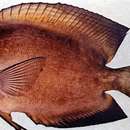Diagnostic Description
provided by Fishbase
Prominent black spot at the rear base of dorsal and anal fins; adults with a bluish ring around the eye (Ref 1602). Dorsal and anal fins dark brown. Caudal fin brown in adults, yellow in young. Edge of lips smooth. Upper teeth usually with 5 denticulations (not including tip). Anterior gill rakers 23-29 (Ref 42056).Description: Characterized further by orange-brown body color with pale spots on head and breast; side of body with longitudinal pale lines; juvenile dark brown body color with blue spots on head and breast, faint blue lines on body; yellow tail; greatest depth of body 1.8-2.0 in SL (Ref. 90102).
- Recorder
- Cristina V. Garilao
Morphology
provided by Fishbase
Dorsal spines (total): 8; Dorsal soft rays (total): 24 - 27; Analspines: 3; Analsoft rays: 22 - 25
- Recorder
- Cristina V. Garilao
Trophic Strategy
provided by Fishbase
Also Ref. 58534.
Biology
provided by Fishbase
Inhabits coral and rubble areas of deep lagoon and seaward reefs. Usually solitary, grazing on surface algae (Ref. 90102). Feeds by scooping film of detritus and unicellular algae (e.g. dinoflagellate Gambierdiscus toxicus) that produce ciguatera toxin making this species a key link in the ciguatera food chain (Ref. 1602, 48637). Caught with nets (Ref. 30573).
- Recorder
- Estelita Emily Capuli
Importance
provided by Fishbase
aquarium: commercial
- Recorder
- Estelita Emily Capuli
分布
provided by The Fish Database of Taiwan
廣泛分布於印度-太平洋區,西起非洲東部,東至土木土群島,北至日本,南至澳洲大堡礁及東加。台灣各地海域及離島均曾發現。
利用
provided by The Fish Database of Taiwan
一般以流刺網、延繩釣或潛水鏢魚法等捕獲。觀賞及食用兼具。剝皮後,煮薑絲湯,肉質鮮美。尾柄上骨質盾板非常銳利,易傷人,處理時需小心。因食物鰱之關係,可能具熱帶海魚毒。
描述
provided by The Fish Database of Taiwan
體呈橢圓形而側扁;尾柄部有一尖銳而尖頭向前之矢狀棘。頭小,頭背部輪廓不特別凸出。口小,端位,上下頜各具刷毛狀細長齒,齒可活動,齒端膨大呈扁平狀。背鰭及臀鰭硬棘尖銳,分別具VIII棘及III棘,各鰭條皆不延長;胸鰭近三角形;尾鰭內凹。體被細櫛鱗,沿背鰭及臀鰭基底有密集小鱗。體呈橘褐色,體側有許多淡藍色波狀縱線,背鰭、臀鰭鰭膜約有5條縱線,頭部及胸部則散佈藍色小點;虹膜藍色。背鰭及臀鰭之後端基部均具黑點。幼魚暗褐色,尾鰭黃色。
棲地
provided by The Fish Database of Taiwan
棲息於石礫底且較深的潟湖和面海礁區海域,棲息深度在8-53公尺左右。主要以生長在碎石區的藻類為食。
Ctenochaetus binotatus
provided by wikipedia EN
Ctenochaetus binotatus, commonly known as the twospot surgeonfish, is a tang fish native to the Indo-Pacific region, excluding the Red Sea, Hawaii and the Marquesan Islands.[2][1]
It is a reef fish occurring at depths from 10–50 m (33–164 ft) and can grow to 22 cm in length.[2] It is a brownish colour with green tinged stripes along the body and similarly coloured spots on the face. The eye is surrounded by a small area of vivid blue.
It occasionally makes its way into the aquarium trade.
References

- license
- cc-by-sa-3.0
- copyright
- Wikipedia authors and editors
Ctenochaetus binotatus: Brief Summary
provided by wikipedia EN
Ctenochaetus binotatus, commonly known as the twospot surgeonfish, is a tang fish native to the Indo-Pacific region, excluding the Red Sea, Hawaii and the Marquesan Islands.
It is a reef fish occurring at depths from 10–50 m (33–164 ft) and can grow to 22 cm in length. It is a brownish colour with green tinged stripes along the body and similarly coloured spots on the face. The eye is surrounded by a small area of vivid blue.
It occasionally makes its way into the aquarium trade.
- license
- cc-by-sa-3.0
- copyright
- Wikipedia authors and editors
Description
provided by World Register of Marine Species
Inhabits coral and rubble areas of deep lagoon and seaward reefs. Feed by scooping film of detritus and unicellular algae (e.g. dinoflagellate @Gambierdiscus toxicus@) that produce ciguatera toxin making this species of @Ctenochaetus@ a key link in the ciguatera food chain (Ref. 1602).
Froese, R. & D. Pauly (Editors). (2023). FishBase. World Wide Web electronic publication. version (02/2023).
- license
- cc-by-4.0
- copyright
- WoRMS Editorial Board

